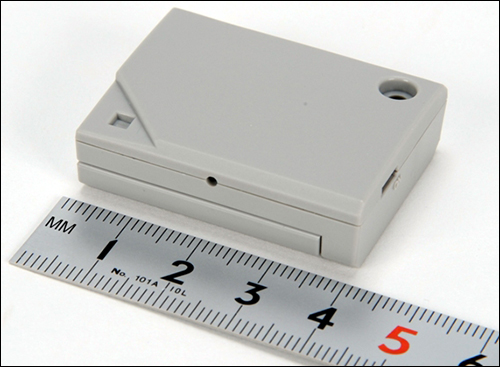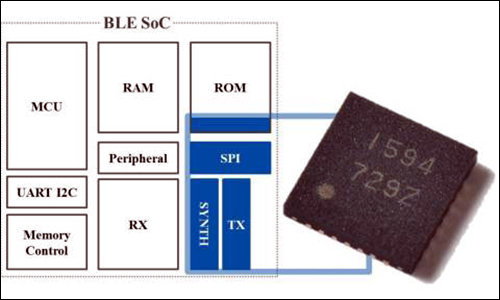Feb 15, 2018The following are news announcements made during the past week by the following organizations:
Fujitsu Components America;
Asahi Kasei Microdevices;
DeltaTrak;
Frost & Sullivan, Smartrac; and
Inmarsat.
Fujitsu Components America Offers BLE Sensor Beacon, Data Logger
Fujitsu Components America has announced that it has expanded its beacon offering with a Bluetooth 4.1 sensor beacon featuring data-logging capability for on-demand reporting in remote monitoring and tracking applications. These include indoor navigation, asset management and retail marketing.
The FWM8BLZ02A-109069 beacon monitors temperature, inclination, vibration and motion data, and records it to non-volatile memory inside the beacon. It is capable of storing up to 68 hours of data at 60-second intervals, or 42 days of data at 15-minute intervals, with a maximum storage capacity of 32 kilobytes.

To reduce clutter within a network, data downloads to a host device can be user-specified for preset intervals, either on a schedule or on demand via a Bluetooth router. Data can be transferred to a smartphone, a tablet, or a Microsoft Windows 8.1 or Windows 10 host device.
The beacon is based on Nordic Semiconductor's Bluetooth Low Energy (BLE) nRF51822 system-on-chip (SoC) to control the wireless connectivity, sensors, LED and battery management. The device measures 40 millimeters by 31 millimeters by 12 millimeters (1.6 inches by 1.2 inches by 0.5 inch) and operates on a single CR2450 coin cell battery with a life expectancy of more than two years.
The FWM8BLZ02A-109069 has an operating temperature range of -30 degrees to +60 degrees Celsius (-1.2 to +2.4 degrees Fahrenheit), at 20 percent to 80 percent relative humidity. It is compliant with the Apple iBeacon and Google Eddystone formats for basic advertising, and allows for sensor and memory enhancements and over-the-air updates. Fujitsu offers sample codes for iOS and Android to assist with developing smartphone application software. The device is available now.
Asahi Kasei Microdevices Develops Transmit-Only BLE IC
Asahi Kasei Microdevices Corp. (AKM) has developed the AK1594, a transmit-only Bluetooth Low Energy (BLE) IC that, according to the company, enables the design of beacon solutions with a longer battery life. Beacon solutions using BLE are utilized in various applications, such as monitoring systems, loss-prevention devices, employee attendance management and information guidance to smartphones in shops or exhibitions. Adoption is expected to spread quickly, the company reports.

A BLE beacon can be designed by writing the initial settings and transmission data to the internal EEPROM, since the AK1594 has no microcontroller and is a transmit-only device. This reduces the development period of beacon systems compared to existing BLE ICs that integrate a microcontroller.
Moreover, the company indicates, the AK1594 achieves low power consumption in the field and a maximum +6dBm (typ.) output transmission. The IC offers security protection for advertising channel packet using the AES128 encoding. Samples are available now. The AK1594 has been adopted to ultra-low power consumption beacons by Houwa System Design K.K., in Japan.
DeltaTrak Unveils BLE Wireless Monitoring Solution
Last week, DeltaTrak showcased its FlashLink Bluetooth Low Energy (BLE) Wireless Monitoring Solution at Germany's Berlin ExpoCenter City. "With the current security feature, shippers have the option to require receivers to enter an access code before they can see or download data from the BLE loggers," said Frederick Wu, DeltaTrak's president and CEOs, in a prepared statement. "This gives them that extra layer of data security." A smartphone app sends information from a mobile device to the BLE Web application, where it can then be viewed remotely by authorized users.
This solution is suitable for three types of applications, the company reports, which include 24-7 facility monitoring, pre-cooling operations and delivery routes. With the FlashLink BLE loggers, customers have secure access to data, immediate alert notifications, and reports in PDF and CSV formats.
The FlashLink BLE logger helps suppliers maintain continuous visibility of temperature and humidity during facility monitoring and pre-cooling operations. It is intended for use in thermal mapping and facility monitoring, such as in cold-storage warehouses, distribution centers, greenhouses and temperature-controlled processing, as well as packing and staging areas. Alert notifications are sent to personnel, allowing them to take corrective action before products can become compromised by changes in temperature conditions.
With the FlashLink BLE Wireless Monitoring Solution, the company reports, pre-cooling operations can improve efficiency, increase pallet throughput and extend product shelf life. The loggers monitor produce in cooling tunnels and, when required temperatures are reached, alerts are sent via email or SMS notifications. Instead of pre-cooling based on time and relying on personnel to take pulp temperature readings, this automates tracking and provides real-time temperature conditions throughout the process. Data can be analyzed by personnel to identify strengths and weaknesses of their operations, and to assure that products are adequately cooled, while eliminating the problem of pallets not being cooled sufficiently.
For delivery routes, receivers can read temperature history data from the FlashLink BLE Logger without opening vehicle doors or locating the logger inside a truck. As soon as a vehicle arrives, the smartphone application accesses data from the logger from a distance of up to 100 feet away, which means information is available immediately.
The FlashLink BLE Logger's settings are customizable, including device name, logging interval, and high or low alarm limits. All data is available in the cloud, where temperature and location are reviewed remotely for tracking shipments in progress, as well as making cold chain management decisions and reports for audits, HACCP and FSMA documentation.
Frost & Sullivan Honors Smartrac for Its RFID Solutions
Based on its recent analysis of the radio frequency identification technology solutions market, Frost & Sullivan has presented Smartrac with its 2018 Europe Company of the Year Award for offering unique value through consumer experience innovation with its Smart Cosmos solutions suite. Smartrac. a global provider of scalable RFID-based solutions, provides a spectrum of inlays, tags, hard tags and solutions for industrial, logistics and retail applications.
Smartrac launched its Internet of Things (IoT) platform, Smart Cosmos, to provide customers with the visibility and control they require to digitize their businesses by securely connecting every product with Smart Cosmos-based solutions, such as Metrics and Experiences. The Smart Cosmos Metrics solution leverages real-time, live product data to show what is happening in retail stores and the supply chain. This data provides complete transparency of in-store business and inventory across a retailer's organization, enabling higher sales and better customer service. The Smart Cosmos Experiences solution offers customers exclusive experiences and dynamic interactions via a mobile phone.
"With Smart Cosmos, Smartrac leaps ahead of competitors in the RFID market," said Ram Ravi, an industry analyst at Frost & Sullivan, in a prepared statement. "The Smart Cosmos solutions suite leverages smart connectivity that allows retailers to 'see' product stocks in real time rather than the traditional RFID technologies that provide product data in batches. The Smart Cosmos platform provides a direct communication channel between the brand and consumer, providing real-time insights into customers' behavior both post-sales and at the point of sale."
Smartrac operates a global R&D organization that holds approximately 1,000 patents and patent applications. The company's focus on scientific research enables it to develop products and solutions that meet challenges in the RFID market. Each year, Frost & Sullivan presents an award to the organization that demonstrates excellence in terms of growth strategy and implementation in its field. The award recognizes a high degree of innovation with products and technologies, and the resulting leadership in terms of customer value and market penetration.
Inmarsat Says IoT Will Play Major Role in Protecting Agricultural Workers
The farm of the future will leverage Internet of Things (IoT) technologies to create safer working environments and drive down risks to the workforce, according to an independent study commissioned by global mobile satellite company Inmarsat. The firm found that half of all agritech companies will strengthen the sector's health and safety practices via IoT adoption.
Market research specialist Vanson Bourne interviewed 100 agritech companies from across the world as part of Inmarsat's "The Future of IoT in Enterprise" study. The report found that 49 percent of agritech companies rate improving health and safety as one of their primary motivations for developing IoT solutions, ahead of monitoring environmental changes (48 percent), and identifying efficiency gains and cost-saving opportunities (45 percent). In a similar vein, 40 percent expect the IoT to bring significant improvements to health and safety practices in the near future.
"Despite industry efforts to improve health and safety in agriculture, research from the International Labour Organisation reveals that the rate of fatal accidents has remained high, and that it continues to be the world's most dangerous industry," said Chris Harry-Thomas, Inmarsat Enterprise's director of agritech strategy, in a prepared statement. "It estimates that 170,000 agricultural workers are killed each year, and that millions more suffer injuries from accidents with agricultural machinery or negative long-term health effects from exposure to agrochemicals and pesticides.
"With the Fourth Agricultural Revolution under way, IoT can present agritech businesses with a wealth of solutions to these challenges," Harry-Thomas added in the statement. "Automated systems, enabled by IoT, can reduce risk by removing workers from the most dangerous procedures, such as lifting heavy materials or operating dangerous machinery. Automated machinery can also typically respond quicker to emergencies, monitoring and stopping equipment before there is a threat to worker safety. The industry is also leveraging the Internet of Things through the form of wearable technologies. These devices, integrated into watches, helmets and clothing, can detect falls and monitor staff health through heart rate and temperature, enabling agricultural businesses to react more quickly to emergencies and bring rapid response medical attention to injured staff."
He added: "As agriculture expands into new and more remote land, terrestrial connectivity becomes increasingly limited. Workers are also exposed to greater risk, as they are more isolated and further away from emergency services. Satellite communication therefore has an integral role to play as it enables cutting edge technologies to be accessed in the most remote areas of the planet, equipping farms with networks of automated devices and sensors to protect workers. We are passionate about driving the momentum behind the Internet of Things and creating safer and more productive working environments across the world. It's encouraging to see that the sector is taking steps to develop and deploy these technologies and safeguard the health, safety and welfare of their staff."
To view the research microsite and download the full report, visit research.inmarsat.com.

